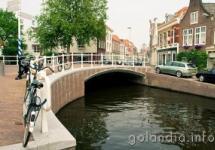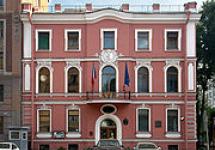Architecture (Architectura) - art design and build buildings, structures that organize a spatial environment, the art of forming this environment for the life and activities of people delivering aesthetic pleasure. One of the most useful arts person is architecture. If you compare architecture with other arts, then as we are concerned about the closer music. After all, the music is as well as architecture and mathematics, has no analogues in the outside world - its shape is abstract. Did it be the basis for a constant comparison of architecture with music? "Frozen music" called the architecture F. Shelling; "Related melody" - I.-V. Goethe.
Many composers were subtle connoisseurs of architecture. From ancient times, a person learned to build a home for himself. For this, natural materials were used, which was rich in the surrounding area. A large number of houses formed settlements. For defense from the enemies of the settlement, they were shared by the walls, wallped with a tight or frequency, a shoulder or a wooden wall. Therefore, the Russian word "city" initially meant "strengthening" and there was an "crap" expressions, "to embroider a fence", "fence".
The layout and construction of cities is one of the areas of architecture, it was called "urban planning". The layout of the cities of antiquity, Middle Ages, the Renaissance, the Old Russian cities differed in many ways.
In antiquity on a fortified hill built temple complex. An example is the Athenian Acropolis - political, religious, cultural center of the city. He was a guideline among the located at the bottom of the rectangular street grid.
Each medieval city was fencing with mighty stone walls with teeth and towers, surrounded deep moat, making it a powerful, reliable fortress. The city-fortress had a defensive importance, to master his gate meant to master
all city. Unlike the Western European city, concluded in high stone walls, once and forever defined its borders, the city of medieval Russia was merged with nature and rural environment. The Russian city and its defensive fortifications were raised taking into account the conditions of the natural landscape. An important role in choosing a place for the future city was playing aesthetic feeling of people. The chronicles have kept many stories containing such messages: "And the place of the place is red and forest on the mountain ... and having loved the place and thoughts, and the Gradean Mal" will coach on it). The city usually grown on an exalted place. Central place In his composition and silhouette, he held a degree (from the XIV century. - Kremlin). He was an inner core of urban fortifications, people left behind his defense after the fall of the external belt of defense. The Kremlin focused the largest, monumental structures - the Cathedral and the Palace.
A characteristic example is the plan of ancient Moscow.
The center of the Western European city was cathedral. Nearby was the administrative building of the Town Hall and market Square. Streets flocked them on the tangent of the city gate. The feudal castle was located behind the city feature. The Economic and Strategic Center of the Eastern Medieval City was the area on which the Madrasa was built - the Higher School, which prepares servants of the cult, teachers, etc. Next to the mosque
minarets - towers from which Muslims called on prayer. The Palace of the ruler and the trading part of the city of Karavan-Sarai, Bazaar (trading dome) played an important role in the architectural composition of the city. From the square to the city gate escaped the road. On them in peacetime went to the city of caravans from all over the world, in war time Moved warriors.
In the era of the Renaissance, the architects once again turned to the ancient tradition of urban planning: at the end of wide straight streets, somehow was accompanied by some architectural ensembledefining the magnitude of perspective.
On this principle, St. Petersburg was built. He was built according to the plan, predetermined and carefully verified by Peter I. Streets and prospectuses in the central part of
Slide 1.
Architecture historic city

Slide 2.
Map of Moscow XVI century
Architecture (Architectura) - art design and build buildings, structures that organize a spatial environment, the art of forming this environment for the life and activities of people delivering aesthetic pleasure.
One of the most useful arts person is architecture.

Slide 3.
"Frozen music" called the architecture F. Shelling; "Related melody" - I.-V. Goethe. Many composers were subtle connoisseurs of architecture. From ancient times, a person learned to build a home for himself. For this, natural materials were used, which was rich in the surrounding area. A large number of houses formed settlements. For defense from the enemies of the settlement, they were shared by the walls, wallped with a tight or frequency, a shoulder or a wooden wall. Therefore, the Russian word "city" initially meant "strengthening" and there was an "crap" expressions, "to embroider a fence", "fence".

Slide 4.
The layout and construction of cities is one of the areas of architecture, it was called "urban planning". The layout of the cities of antiquity, Middle Ages, the Renaissance, the Old Russian cities differed in many ways. In antiquity on a fortified hill built a temple complex. An example is the Athenian Acropolis - political, religious, cultural center of the city. He was a guideline among the located at the bottom of the rectangular street grid.
Accorinf. Greece
Athenian Acropolis. Greece

Slide 5.
Each medieval city was fencing with mighty stone walls with teeth and towers, surrounded deep moat, making it a powerful, reliable fortress. The city-fortress had a defensive importance, to master his gates meant to master all the city. The center of the Western European city was the Cathedral. The administrative building of the Town Hall and the Market Square was located nearby.
Square and building of the city hall. Prague

Slide 6.
in medieval Rus - the city usually grew on an exalted place. The central place in his composition and silhouette was held by the ladies (from the XIV century. - Kremlin). He was an inner core of urban fortifications, people left behind his defense after the fall of the external belt of defense. The Kremlin focused the largest, monumental structures - the Cathedral and the Palace. A characteristic example is the plan of ancient Moscow.
Novgorod Keynets. Modern aerial photography

Slide 7.
The economic and strategic center of the Eastern Medieval city was the area on which the Madrasa was built - the Higher School, which prepares servants of the cult, teachers, etc.
Register. SAMARKAND. Uzbekistan

Slide 8.
In the era of the Renaissance, the architects once again turned to the ancient tradition of urban planning: at the end of wide straight streets, some architectural ensemble had begun, determining the magnitude of the prospects. On this principle, St. Petersburg was built. He was built according to plan, in advance and carefully calmed by Peter I. Streets and prospectuses in the central part of the city by Trident converge to squares.
Map of St. Petersburg began the XX century.
St. Petersburg. Historical Center

Slide 9.
Homework:
Find poems about the two capitals of Russia - Moscow and St. Petersburg, dedicated to the architectural attractions of these cities. Read their classmates. How do you understand the meaning of expressions: "Architecture - Frozen Music" and "Architecture - Related Melody"? What is common between music and architecture?
Architecture (Architectura) - art design and build buildings, structures that organize a spatial environment, the art of forming this environment for the life and activities of people delivering aesthetic pleasure.
One of the most useful arts person is architecture.
Slide 3.
"Frozen music" called the architecture F. Shelling; "Related melody" - I.-V. Goethe. Many composers were subtle connoisseurs of architecture. From ancient times, a person learned to build a home for himself. For this, natural materials were used, which was rich in the surrounding area. A large number of houses formed settlements. For defense from the enemies of the settlement, they were shared by the walls, wallped with a tight or frequency, a shoulder or a wooden wall. Therefore, the Russian word "city" initially meant "strengthening" and there was an "crap" expressions, "to embroider a fence", "fence".
Slide 4.
The layout and construction of cities is one of the areas of architecture, it was called "urban planning". The layout of the cities of antiquity, Middle Ages, the Renaissance, the Old Russian cities differed in many ways.
In antiquity on a fortified hill built a temple complex. An example is the Athenian Acropolis - political, religious, cultural center of the city. He was a guideline among the located at the bottom of the rectangular street grid.
- Accorinf. Greece
- Athenian Acropolis. Greece
Slide 5.
Each medieval city was fencing with mighty stone walls with teeth and towers, surrounded deep moat, making it a powerful, reliable fortress. The city-fortress had a defensive importance, to master his gates meant to master all the city.
The center of the Western European city was the Cathedral. The administrative building of the Town Hall and the Market Square was located nearby.
Square and building of the city hall. Prague
Slide 6.
in medieval Rus - the city usually grew on an exalted place. The central place in his composition and silhouette was held by the ladies (from the XIV century. - Kremlin). He was an inner core of urban fortifications, people left behind his defense after the fall of the external belt of defense. The Kremlin focused the largest, monumental structures - the Cathedral and the Palace. A characteristic example is the plan of ancient Moscow.
Novgorod Keynets. Modern aerial photography
Slide 7.
The economic and strategic center of the Eastern Medieval city was the area on which the Madrasa was built - the Higher School, which prepares servants of the cult, teachers, etc.
Register. SAMARKAND. Uzbekistan
Slide 8.
In the era of the Renaissance, the architects once again turned to the ancient tradition of urban planning: at the end of wide straight streets, some architectural ensemble had begun, determining the magnitude of the prospects. On this principle, St. Petersburg was built. He was built according to plan, in advance and carefully calmed by Peter I. Streets and prospectuses in the central part of the city by Trident converge to squares.
- Map of St. Petersburg began the XX century.
- St. Petersburg. Historical Center
Slide 9.
Homework:
Find poems about the two capitals of Russia - Moscow and St. Petersburg, dedicated to the architectural attractions of these cities. Read their classmates.
How do you understand the meaning of expressions: "Architecture - Frozen Music" and "Architecture - Related Melody"? What is common between music and architecture?
View all slides





















 Back forward
Back forward
Attention! Preview slides is used exclusively for informational purposes and may not provide ideas about all presentation capabilities. If you are interested in this work, please download the full version.
Thing: art
Class9
Theme and number in the section: 18 lesson in the section "Dar of Creation", theme: "Architecture of the historic city".
Basic textbook: G.P. Sergeeva, and, K. Kashshova, E.D. Krit "Art", M.: "Enlightenment". 2011
Goal: Familiarize students with the characteristic features of urban planning of different eras and times.
Tasks:
- Training:introductory students with the characteristic features of urban planning of different eras and times;
- Developing: Develop cognitive processes: memory, thinking, observation, attention, the ability to analyze, draw conclusions, the ability to express their allegations, develop oral speech skills, communicativeness.
- Educational:education of aesthetic taste, respect for world history and traditions.
Type of lesson: The lesson is the acquisition of new titles.
Form of work study: Frontal, individual, group.
Necessary technical equipment: Computer, projector, screen, columns.
Plan Abstract lesson
Stage |
Task step |
Educational task |
Material |
The action of the teacher |
Student's action |
Introduction |
Self-determination in activities |
Allocate the features of the plan scheme of cities of different eras |
Music of the Renaissance, bell ringing, oriental jerseys. Engravings |
It is proposed to consider various planning of cities of various eras: antiquity, Middle Ages, Renaissance, ancient Russian city |
Work in groups. (5-7min) Compare planning - schemes, analyze: an antique temple (Athenian Acropolis), a medieval city, the Western European city, the medieval city of Russia. Eliminate the essential signs of each city and their features, and the difference. (5-7 min.) |
Exposition |
Building a draft decision of the educational task |
Highlight architectural species which have a large emotional impact on man. |
It is proposed to compare the features of cities in different era: ancient times, antiquity, the Middle Ages Western Europe, Middle Ages in Russia, Middle Ages in the East, Revival. |
Work in groups. (5-7 min.) Compare the architecture of historic cities. Different eras and styles: architecture of the Moscow Kremlin (presentation). Architecture eastern City (Presentation), Western European city (presentation). Pick up the verses dedicated to the sights of any city of the world (home billets) (5-7 min.) |
|
Culmination |
Decision of the learning task |
Significant signs of synthetic arts in urban planning |
Table "Feature of architecture of historic cities" |
Directs students to the disclosure of the emotional perception of ancient cities, fortresses, retail space, cult builds through artwork artists and musicians who melted the beauty of ancient cities. |
Work in groups (5-7 min.) Consider vintage engravings. Includes ancient fortresses, retail space, wide avenues and narrow streets . In creative notebooks (10 min.) Write your understanding and statement "Architecture Frozen Music, and" Architecture Related Melody "What is common between architecture and music?. |
Decision of the educational task in the new situation |
Use new knowledge in new conditions |
Offers: Using the feather and mascara, draw a diagram of a medieval city, oriental or European city with their characteristic features |
Practical work. (individual) (15 min.) Perform on the A4 sheet graphic image of the plan - the schemes of the medieval city, the eastern or European city with their characteristic features of the choice. Discussion, work analysis. Questions for fixing the material. |
Task number 1
Compare planning schemes and find the difference in an ancient temple (Athenian Acropolis), a medieval city, the Western European city, the medieval city of Russia. Select the essential signs of each city and their features.
Task number 2.
Pick up verses dedicated to the sights of any city of the world (home billets)
Task number 3.
Work in creative notebooks:
Consider vintage engravings. They find the ancient fortresses, retail space, wide avenues and narrow streets.
Record your understanding of the statements: "Architecture Frozen Music", "Architecture Recommended Melody".
Find what is common between architecture and music.
Express your thoughts (orally), which is common between music and architecture. Share their impressions.
Practical work individual (15 min.)
Perform on a sheet A4 graphic image of the plan scheme. Transfer to specific traits Russian, European and eastern, medieval city (optional).
Discussion, work analysis.
Material consolidation issues: What is the difference in the architecture of historic cities?
- Antique
- Russian
- Western European
- Eastern
Evaluation: Explained on the results of work in groups and for individual practical work.
The lesson uses the material:
- Presentation "Architecture of Historic Cities"
- Photos of characteristic medieval cities
- Reproductions of vintage engravings
- Music of the Renaissance, Bell Ringing, Eastern Tunes
"The form of the building" - much more often there are buildings with a more complex composition. The highest skyscraper in Dubai. Time, money, organizational abilities. Perform a creative task: connect the bulk forms into a single architectural look. PROPPRPRRPRPPRPRRRRRRR. Compound of volumes on the example of the temple. Answer the questions:
"Architectural Bionics" - main directions. Shell thickness. Sheet of cuffs. Examples of structures. The principle of cone. Ribbed structures. Designs having a view of a spiral. Nature. Shell. Architectural bionics. Cone-shaped designs. New page. Constructions with pre-voltage. Frame. Engineers. The abilities of plants.
"Geometry in architecture" - Japanese architecture is based on the samples of Chinese since the spread of Buddhism. Terrestrial buildings inside were decorated with flat reliefs. In pictures. The latitude of urban planning, distinguishes the Roman architecture. Architecture of Greece. The first temples and the first statues from the stone appeared here in the VII century. BC e.
"Fountains" - attach thin tubes to the statuette. History of fountains. Branch of science. Beauty of water. Decorating the bottom of the fountain. First fountains. The basis for the fountain is ready. Plan to create a valid model of the fountain. Fix with glue Heart based on. Jet. What are the fountains. Fix at a permanent place.
"Mathematics in architecture" - symmetry - Queen of architectural perfection. Mathematics in architecture. Architecture. Hyperbolic paraboloid. Hyperboloid. Golden cross section in architecture. Geometric forms in different architectural styles. Construction strength. Mathematics and architecture. Egyptian geometry. Mathematics helps to achieve the strength of structures.
"Harmony" - arches appeared, dome. AT Ancient Egypt Special artisans were engaged in measurements. There was time, mathematical tasks of architecture became complicated. The buildings in the figure provide themselves with solar and thermal energy. Mathematics and architecture. It is impossible to describe all the variety of geometric techniques, which owned architects.



